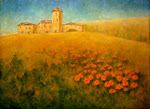The Apulia (Puglia in Italian) region forms Italy’s “heel.” Although somewhat off the beaten track, this region is a “must-see” for artists. If time is not on your side, at least in addition to the Trulli in Alberobello of which I’ve previously written (see March 17th entry), a trip to Lecce is not to be missed.
Referred to by some as the “Florence of the Italian South,” Lecce is a city of Baroque run wild. The palaces, churches, balconies, courtyards, and even modest side-street houses are embellished with gargoyles, eagles, monkeys, dragons, saints, fruit, and flowers. But unlike the Baroque style found elsewhere in Europe, Lecce Baroque isn’t massive or imposing; quite the opposite, it’s airy and joyful. This ornamental explosion is mostly due to the “Pietra di Lecce,” the honey-colored stone quarried in the region that is so malleable it can be cut with a knife. Nothing was too intricate or delicate that it couldn’t be carved from this stone. It would have been impossible to achieve the Lecce Baroque out of marble.
Piazza Sant’Oronzo is an excellent location for setting up your easel. When you feel the need to take a break so as not to suffer a Baroque overload, visit the below ground-level remains of the 1st century BC Roman amphitheater that Adjoins Piazza Sant’Oronzo. It’s most remarkable for it’s illustrations of chiseled gladiators fighting back lions with spears and less successful gladiators being gored by bulls.
Artists who like detailed paintings will delight in painting the Church of the Rosario on Via G. Libertini. The entire façade is a riot of carved birds and flora. At one time the monks at this cloister, which now houses a tobacco company, manufactured “polvere Leccese,” (Lecce dust) the famous snuff that Napoleon used throughout his career until his last days on St. Helena. Maybe that explains the pose with his hand inside his jacket: he was reaching for his snuffbox.
BUON VIAGGIO!
Welcome
Many artists dream about painting in Italy. Now, as retiring baby-boomers are increasingly taking up “brush and pallet knife,” more than ever, painting in Italy is the “thing.” Every day, a new “Artist’s” tour of Italy crops up in travel sections of the newspaper and on the Internet. But there still remains a majority of artists who prefer to “go it alone.” They are independent in their artistic styles, and prefer to be independent regarding their travels in Italy . This blog intends to target these free spirited artists who still need guidance to the best places to paint, especially those idyllic gems that are little known and less traveled. Certainly, independent travelers who are not artists will also benefit from this blog.
With a few exceptions, this blog is not a guide to restaurants, lodging, rental cars, or shopping, (except for art supplies.)
Sprinkled among the posts are: my paintings, and a few Italian proverbs and poems written by notable Italian authors for whom I work as a translator.
Please visit my website to view my original art:
http://www.pamelaallegretto-franz.com/
Giclee prints of my paintings, ranging from greeting size to poster size, can be purchased at:
http://pamela-allegretto.fineartamerica.com/
With a few exceptions, this blog is not a guide to restaurants, lodging, rental cars, or shopping, (except for art supplies.)
Sprinkled among the posts are: my paintings, and a few Italian proverbs and poems written by notable Italian authors for whom I work as a translator.
Please visit my website to view my original art:
http://www.pamelaallegretto-franz.com/
Giclee prints of my paintings, ranging from greeting size to poster size, can be purchased at:
http://pamela-allegretto.fineartamerica.com/
Tuesday, October 20, 2009
Subscribe to:
Post Comments (Atom)











nice article, really
ReplyDeleteThis is great! I stumbled upon your blog while searching for information on Lecce for a bike tour of southern Italy I'll be leading this spring. Normally we follow via Appia from Rome to Brindisi but I decided to extend the ride to Lecce this year. Your blog post has justified my decision. Thanks, and I look forward to reading more.
ReplyDelete--Jacob